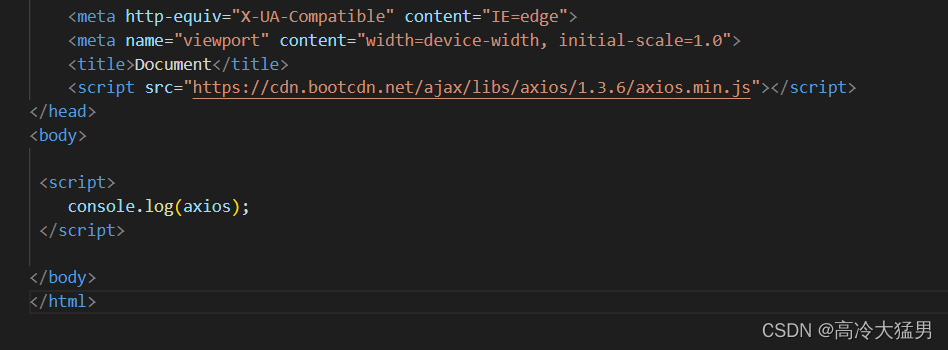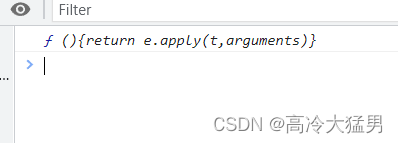Axios概述
一、Json-server
获得零编码的完整伪造 REST API zero coding 在不到 30 秒的时间内 (认真)。
使用 <3 创建,适用于需要快速后端进行原型设计和模拟的前端开发人员,模拟后端发送过来json数据。
1.安装
npm install -g json-server2.创建一个 db.json 包含一些数据的文件
{
"posts": [
{ "id": 1, "title": "json-server", "author": "typicode" }
],
"comments": [
{ "id": 1, "body": "some comment", "postId": 1 }
],
"profile": { "name": "typicode" }
}3.json-server --watch db.json
二、Axios
2.1概念
Axios 是一个基于 promise 的 HTTP 库,可以用在浏览器和 node.js 中。
2.2特性
从浏览器中创建 XMLHttpRequests
从 node.js 创建 http 请求
支持 Promise API
拦截请求和响应
转换请求数据和响应数据
取消请求
自动转换 JSON 数据
客户端支持防御 XSRF
下述代码获得axios对象


三、axios API
axios(config)
发送GET请求,查询
aa.onclick = ()=>{
//发送AJAX请求
axios({
//请求类型
method:'GET',
url:'http://localhost:3000/posts',
}).then(response =>{
console.log(response);
});
}发送post请求,添加
bb.onclick = ()=>{
//发送AJAX请求
axios({
//请求类型
method:'POST',
url:'http://localhost:3000/posts',
data:{
title:"是秀秀呀!",
author:"魔镜魔镜谁是世界上最乖的宝宝"
}
}).then(response =>{
console.log(response);
});
}发送put请求,修改
cc.onclick = ()=>{
//发送AJAX请求
axios({
//请求类型
method:'PUT',
url:'http://localhost:3000/posts/4',
data:{
title:"是秀秀呀! \{^_^}/ hi!",
author:"魔镜魔镜谁是世界上最乖的宝宝"
}
}).then(response =>{
console.log(response);
});
}
发送delete请求,删除
dd.onclick = ()=>{
//发送AJAX请求
axios({
//请求类型
method:'DELETE',
url:'http://localhost:3000/posts/1',
}).then(response =>{
console.log(response);
});
}axios(url[, config])
// 发送 GET 请求(默认的方法)
axios('/user/12345');四、axios通过其他方式发送请求
axios.request(config)
axios.get(url[, config])
axios.delete(url[, config])
axios.head(url[, config])
axios.options(url[, config])
axios.post(url[, data[, config]])
axios.put(url[, data[, config]])
axios.patch(url[, data[, config]])
注意
在使用别名方法时,
url、method、data这些属性都不必在配置中指定。
axios.request请求
const aa = document.getElementById("aa");
aa.onclick = function(){
axios.request({
method:'GET',
url:'http://localhost:3000/comments'
}).then(response=>{
console.log(response);
})
}
axios.post请求
const bb = document.getElementById("bb");
bb.onclick = function(){
axios.post(
'http://localhost:3000/comments',
{
"body":"喜羊羊美羊羊",
"postid":2
}
).then(response =>{
console.log(response);
})
}
五、创建axios实例
axios.create([config])
<script>
const instance = axios.create({
baseURL:'https://api.apiopen.top/api',
//超时时间
timeout:1000,
});实例的方法
axios#request(config)
axios#get(url[, config])
axios#delete(url[, config])
axios#head(url[, config])
axios#options(url[, config])
axios#post(url[, data[, config]])
axios#put(url[, data[, config]])
axios#patch(url[, data[, config]])方法示例
instance({
url:'/getImages?type=comic&page=10&size=20',
}).then(response=>{
console.log(response);
}) instance.get('/getImages?type=comic&page=10&size=20').then(Response=>{
console.log(Response);
})六、axios拦截器
在请求或响应被 then 或 catch 处理前拦截它们。
<script>
// 添加请求拦截器
axios.interceptors.request.use(function (config) {
// 在发送请求之前做些什么
// console.log('请求拦截器成功');
throw '失败';
return config;
}, function (error) {
console.log('请求拦截器失败');
// 对请求错误做些什么
return Promise.reject(error);
});
// 添加响应拦截器
axios.interceptors.response.use(function (response) {
console.log('响应拦截器成功');
// 对响应数据做点什么
return response;
}, function (error) {
console.log('响应拦截器失败');
// 对响应错误做点什么
return Promise.reject(error);
});
axios({
method:'GET',
url:'http://localhost:3000/posts'
}).then(response=>{
console.log("自定义回调方法成功")
}).catch(reason=>{
console.log('自定义失败回调');
})
</script>如果请求拦截器失败,那么响应拦截器也失败,走的时失败回调。响应拦截器成功,但是抛出异常走的也时失败拦截器跟失败回调。
七、请求配置
{
// `url` 是用于请求的服务器 URL
url: '/user',
// `method` 是创建请求时使用的方法
method: 'get', // default
// `baseURL` 将自动加在 `url` 前面,除非 `url` 是一个绝对 URL。
// 它可以通过设置一个 `baseURL` 便于为 axios 实例的方法传递相对 URL
baseURL: 'https://some-domain.com/api/',
// `transformRequest` 允许在向服务器发送前,修改请求数据
// 只能用在 'PUT', 'POST' 和 'PATCH' 这几个请求方法
// 后面数组中的函数必须返回一个字符串,或 ArrayBuffer,或 Stream
transformRequest: [function (data, headers) {
// 对 data 进行任意转换处理
return data;
}],
// `transformResponse` 在传递给 then/catch 前,允许修改响应数据
transformResponse: [function (data) {
// 对 data 进行任意转换处理
return data;
}],
// `headers` 是即将被发送的自定义请求头
headers: {'X-Requested-With': 'XMLHttpRequest'},
// `params` 是即将与请求一起发送的 URL 参数
// 必须是一个无格式对象(plain object)或 URLSearchParams 对象
params: {
ID: 12345
},
// `paramsSerializer` 是一个负责 `params` 序列化的函数
// (e.g. https://www.npmjs.com/package/qs, http://api.jquery.com/jquery.param/)
paramsSerializer: function(params) {
return Qs.stringify(params, {arrayFormat: 'brackets'})
},
// `data` 是作为请求主体被发送的数据
// 只适用于这些请求方法 'PUT', 'POST', 和 'PATCH'
// 在没有设置 `transformRequest` 时,必须是以下类型之一:
// - string, plain object, ArrayBuffer, ArrayBufferView, URLSearchParams
// - 浏览器专属:FormData, File, Blob
// - Node 专属: Stream
data: {
firstName: 'Fred'
},
// `timeout` 指定请求超时的毫秒数(0 表示无超时时间)
// 如果请求话费了超过 `timeout` 的时间,请求将被中断
timeout: 1000,
// `withCredentials` 表示跨域请求时是否需要使用凭证
withCredentials: false, // default
// `adapter` 允许自定义处理请求,以使测试更轻松
// 返回一个 promise 并应用一个有效的响应 (查阅 [response docs](#response-api)).
adapter: function (config) {
/* ... */
},
// `auth` 表示应该使用 HTTP 基础验证,并提供凭据
// 这将设置一个 `Authorization` 头,覆写掉现有的任意使用 `headers` 设置的自定义 `Authorization`头
auth: {
username: 'janedoe',
password: 's00pers3cret'
},
// `responseType` 表示服务器响应的数据类型,可以是 'arraybuffer', 'blob', 'document', 'json', 'text', 'stream'
responseType: 'json', // default
// `responseEncoding` indicates encoding to use for decoding responses
// Note: Ignored for `responseType` of 'stream' or client-side requests
responseEncoding: 'utf8', // default
// `xsrfCookieName` 是用作 xsrf token 的值的cookie的名称
xsrfCookieName: 'XSRF-TOKEN', // default
// `xsrfHeaderName` is the name of the http header that carries the xsrf token value
xsrfHeaderName: 'X-XSRF-TOKEN', // default
// `onUploadProgress` 允许为上传处理进度事件
onUploadProgress: function (progressEvent) {
// Do whatever you want with the native progress event
},
// `onDownloadProgress` 允许为下载处理进度事件
onDownloadProgress: function (progressEvent) {
// 对原生进度事件的处理
},
// `maxContentLength` 定义允许的响应内容的最大尺寸
maxContentLength: 2000,
// `validateStatus` 定义对于给定的HTTP 响应状态码是 resolve 或 reject promise 。如果 `validateStatus` 返回 `true` (或者设置为 `null` 或 `undefined`),promise 将被 resolve; 否则,promise 将被 rejecte
validateStatus: function (status) {
return status >= 200 && status < 300; // default
},
// `maxRedirects` 定义在 node.js 中 follow 的最大重定向数目
// 如果设置为0,将不会 follow 任何重定向
maxRedirects: 5, // default
// `socketPath` defines a UNIX Socket to be used in node.js.
// e.g. '/var/run/docker.sock' to send requests to the docker daemon.
// Only either `socketPath` or `proxy` can be specified.
// If both are specified, `socketPath` is used.
socketPath: null, // default
// `httpAgent` 和 `httpsAgent` 分别在 node.js 中用于定义在执行 http 和 https 时使用的自定义代理。允许像这样配置选项:
// `keepAlive` 默认没有启用
httpAgent: new http.Agent({ keepAlive: true }),
httpsAgent: new https.Agent({ keepAlive: true }),
// 'proxy' 定义代理服务器的主机名称和端口
// `auth` 表示 HTTP 基础验证应当用于连接代理,并提供凭据
// 这将会设置一个 `Proxy-Authorization` 头,覆写掉已有的通过使用 `header` 设置的自定义 `Proxy-Authorization` 头。
proxy: {
host: '127.0.0.1',
port: 9000,
auth: {
username: 'mikeymike',
password: 'rapunz3l'
}
},
// `cancelToken` 指定用于取消请求的 cancel token
// (查看后面的 Cancellation 这节了解更多)
cancelToken: new CancelToken(function (cancel) {
})
}八、响应结构
{
// `data` 由服务器提供的响应
data: {},
// `status` 来自服务器响应的 HTTP 状态码
status: 200,
// `statusText` 来自服务器响应的 HTTP 状态信息
statusText: 'OK',
// `headers` 服务器响应的头
headers: {},
// `config` 是为请求提供的配置信息
config: {},
// 'request'
// `request` is the request that generated this response
// It is the last ClientRequest instance in node.js (in redirects)
// and an XMLHttpRequest instance the browser
request: {}
}